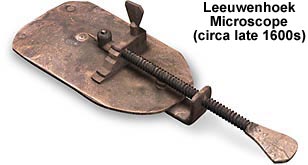Leeuwenhoek Microscope
Antoni van Leeuwenhoek, who lived in the Netherlands between 1632 and 1723, was an amateur in science and lacked any type of formal university training. His experiments with microscopy design and function led him to become an international authority on microscopy and he was granted the honor of Fellowship in the Royal Society in 1680.

Leeuwenhoek designed and built several hundred microscopes that were all very small and had a very similar design and function. The dimensions of his microscopes were fairly constant at approximately two inches long and one inch across. The main body of these microscopes consists of two flat and thin metal (usually brass) plates riveted together. Sandwiched between the plates was a small bi-convex lens capable of magnifications ranging from 70x to over 250x, depending upon the lens quality.
Operation of the Leeuwenhoek microscope is simple. The specimen is placed on a pin that is manipulated by the means two of screws, one to adjust the distance between the specimen and lens and the other to adjust the height of the specimen. The sample translator screw and rod is located at the bottom of the microscope where it passes though a right angled bracket, which secures it to the microscope, and then stops at a metal block located in the middle of the microscope body plates. The specimen-holder pin is connected to the other side of this block, so when the translator screw is turned it moves the specimen up or down. Another screw, placed into the block perpendicular to the microscope plates, serves as a height-adjustment screw. When this screw is turned it pushes against the metal plates and moves the specimen toward or away from the lens, acting in a manner similar to a focus knob. On the back side of the microscope, another screw holds the right angled bracket to the metal body plates and also serves as a pivot point to move the specimen from side to side.
Leeuwenhoek spent a considerable amount of time perfecting the manufacture of lenses for his microscopes, and he was able to grind and polish bi-convex lenses to an amazingly high quality. It is also suspected that Leeuwenhoek used blown-glass lenses and that these lenses were the ones responsible for the incredible magnifications of his simple microscopes. Leeuwenhoek produced these lenses by chipping away the excess glass from the thickened glass droplet that forms on the bottom of a blown-glass bulb. These incredible lenses had a thickness of about one millimeter and a radius of curvature of 0.75 millimeter. They had superior magnification and resolution when compared to the other microscopes of the time. The Utrecht museum has one of Leeuwenhoek's microscopes in its collection. This incredible instrument has a magnification factor of about 275x (even considering a scratch on the lens) with a resolution approaching one micron.
BACK TO SIXTEENTH-SEVENTEENTH CENTURY MICROSCOPES
